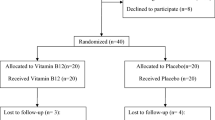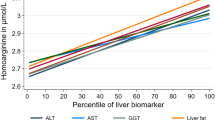Abstract
Objective: To investigate glutathione and amino acids related to glutathione metabolism in patients with anorexia nervosa in order to test the hypothesis that these patients exhibit a deficiency of glutathione and therefore might be at an increased risk of developing toxic liver injury.
Design: Controlled observatory study and case report.
Setting: University Hospital.
Subjects: Subjects included 11 female patients with anorexia nervosa and 12 healthy female controls.
Interventions: Determination of fasting free and total glutathione, homocysteine, vitamins B6 and B12 and folic acid in plasma.
Results: A 14-y-old patient with a body mass index of 12.6 kg/m2 presented with markedly elevated transaminases (ALAT >50 × upper limit of normal), and paracetamol was detected in her blood. Patients with anorexia nervosa exhibited lower circulating concentrations of free cysteine (8.9±1.5 vs 12.0±1.4 μmol/l) and free and total glutathione (5.0±1.3 vs 7.1±1.2 and 11.2±3.8 vs 16.2±5.0 μmol/l, respectively). The plasma concentrations of homocysteine (17.5±4.9 vs 12.0±3.8 μmol/l) and also of glycine (194±37 vs 143±41 μmol/l) and glutamine (422±51 vs 353±51 μmol/l) were significantly higher in patients with anorexia nervosa who were not deficient in folic acid, vitamin B6 and B12.
Conclusions: Lower plasma concentrations of glutathione suggest lower intracellular concentrations of the tripeptide. Higher homocysteine, glycine and glutamine concentrations point to a decreased utilization of these amino acids for glutathione synthesis and an impairment of trans-sulfuration. Consequently, the capacity of patients with anorexia nervosa to detoxify electrophilic metabolites and reactive oxygen species via glutathione may be impaired.
Sponsorship: Supported by Grant 32-52608.97 from the Swiss National Foundation for Scientific Research.
This is a preview of subscription content, access via your institution
Access options
Subscribe to this journal
Receive 12 print issues and online access
$259.00 per year
only $21.58 per issue
Buy this article
- Purchase on Springer Link
- Instant access to full article PDF
Prices may be subject to local taxes which are calculated during checkout






Similar content being viewed by others
References
Adams Jr JD, Lauterburg BH & Mitchell JR (1983): Plasma glutathione and glutathione disulfide in the rat: regulation and response to oxidative stress. J. Pharmacol. Exp. Ther. 227, 749–754.
Barbaro G, Di Lorenzo G, Soldini M, Parrotto S, Bellomo G, Belloni G, Grisorio B & Barbarini G (1996): Hepatic glutathione deficiency in chronic hepatitis C: quantitative evaluation in patients who are HIV positive and HIV negative and correlations with plasmatic and lymphocytic concentrations and with the activity of the liver disease. Am. J. Gastroenterol. 91, 2569–2573.
Bernhard MC, Junker E, Hettinger A & Lauterburg BH (1998): Time course of total cysteine, glutathione and homocysteine in plasma of patients with chronic hepatitis C treated with interferon-alpha with and without supplementation with N-acetylcysteine. J. Hepatol. 28, 751–755.
Bidlingmeyer BA, Cohen SA & Tarvin TL (1984): Rapid analysis of amino acids using pre-column derivatization. J. Chromatogr. 336, 93–104.
Bui MH (1999): A microbiological assay on microtitre plates of thiamine in biological fluids and foods. Int. J. Vitam. Nutr. Res. 69, 362–366.
Cooper AJ (1983): Biochemistry of sulfur-containing amino acids. Annu. Rev. Biochem. 52, 187–222.
Croner S, Larsson J, Schildt B & Symreng T (1985): Severe anorexia nervosa treated with total parenteral nutrition. Clinical course and influence on clinical chemical analyses. Acta Paediatr. Scand. 74, 230–236.
Fukusako T, Negoro K, Tsuda N, Kato M & Morimatsu M (1995): A case of secondary carnitine deficiency due to anorexia nervosa and severe liver damage. Rinsho Shinkeigaku 35, 34–37.
Furuta S, Ozawa Y, Maejima K, Tashiro H, Kitahora T, Hasegawa K, Kuroda S & Ikuta N (1999): Anorexia nervosa with severe liver dysfunction and subsequent critical complications. Intern. Med. 38, 575–579.
Griffith OW & Meister A (1979): Glutathione: interorgan translocation, turnover, and metabolism. Proc. Natl. Acad. Sci. USA 76, 5606–5610.
Hammond CL, Lee TK & Ballatori N (2001): Novel roles for glutathione in gene expression, cell death, and membrane transport of organic solutes. J Hepatol. 34, 946–954.
Higashi T, Tateishi N, Naruse A & Sakamoto Y (1977): A novel physiological role of liver glutathione as a reservoir of L-cysteine. J. Biochem. (Tokyo) 82, 117–124.
Hutteroth TH, Wagner R & Knolle J (1977): Schwere toxische Leberschaedigung nach Ueberdosierung von parenteral verabreichten Kohlenhydraten. Med. Klin. 72, 703–707.
Jewell SA, Di Monte D, Gentile A, Guglielmi A, Altomare E & Albano O (1986): Decreased hepatic glutathione in chronic alcoholic patients. J. Hepatol. 3, 1–6.
Komuta M, Harada M, Ueno T, Uchimura Y, Inada C, Mitsuyama K, Sakisaka S, Sata M & Tanikawa K (1998): Unusual accumulation of glycogen in liver parenchymal cells in a patient with anorexia nervosa. Intern. Med. 37, 678–682.
Lauterburg BH & Velez ME (1988): Glutathione deficiency in alcoholics: risk factor for paracetamol hepatotoxicity. Gut 29, 1153–1157.
Lu SC (1999): Regulation of hepatic glutathione synthesis: current concepts and controversies. FASEB J. 13, 1169–1183.
McClain CJ, Kromhout JP, Peterson FJ & Holtzman JL (1980): Potentiation of acetaminophen hepatotoxicity by alcohol. JAMA 244, 251–253.
Mehta S, Nain CK, Yadav D, Sharma B & Mathur VS (1985): Disposition of acetaminophen in children with protein calorie malnutrition. Int. J. Clin. Pharmacol. Ther. Toxicol. 23, 311–315.
Moyano D, Vilaseca MA, Artuch R & Lambruschini N (1998a): Plasma amino acids in anorexia nervosa. Eur. J. Clin. Nutr. 52, 684–689.
Moyano D, Vilaseca MA, Artuch R, Valls C & Lambruschini N (1998b): Plasma total-homocysteine in anorexia nervosa. Eur. J. Clin. Nutr. 52, 172–175.
Moyano D, Sierra C, Brandi N, Artuch R, Mira A, Garcia-Tornel S & Vilaseca MA (1999): Antioxidant status in anorexia nervosa. Int. J. Eat Disord. 25, 99–103.
Newton GL, Dorian R & Fahey RC (1981): Analysis of biological thiols: derivatization with monobromobimane and separation by reverse-phase high-performance liquid chromatography. Anal. Biochem. 114, 383–387.
Nordgren L & von Scheele C (1977): Hepatic and pancreatic dysfunction in anorexia nervosa: a report of two cases. Biol. Psychiatry 12, 681–686.
Nurk E, Tell GS, Nygard O, Refsum H, Ueland PM & Vollset SE (2001): Plasma total homocysteine is influenced by prandial status in humans: the Hordaland homocysteine study. J. Nutr. 131, 1214–1216.
Pessayre D, Dolder A, Artigou JY, Wandscheer JC, Descatoire V, Degott C & Benhamou JP (1979): Effect of fasting on metabolite-mediated hepatotoxicity in the rat. Gastroenterology 77, 264–271.
Rahman I & MacNee W (2000): Oxidative stress and regulation of glutathione in lung inflammation. Eur. Respir. J. 16, 534–554.
Reed DJ & Orrenius S (1977): The role of methionine in glutathione biosynthesis by isolated hepatocytes. Biochem. Biophys. Res. Commun. 77, 1257–1264.
Reid M, Badaloo A, Forrester T, Morlese JF, Frazer M, Heird WC & Jahoor F (2000): In vivo rates of erythrocyte glutathione synthesis in children with severe protein-energy malnutrition. Am. J. Physiol. Endocrinol. Metab. 278, E405–E412.
Rivera-Nieves J, Kozaiwa K, Parrish CR, Iezzoni J & Berg CL (2000): Marked transaminase elevation in anorexia nervosa. Dig. Dis. Sci. 45, 1959–1963.
Schenker S, Speeg Jr KV, Perez A & Finch J (2001): The effects of food restriction in man on hepatic metabolism of acetaminophen. Clin. Nutr. 20, 145–150.
Seeff LB, Cuccherini BA, Zimmerman HJ, Adler E & Benjamin SB (1986): Acetaminophen hepatotoxicity in alcoholics. A therapeutic misadventure. Ann. Intern. Med. 104, 399–404.
Staal FJ, Ela SW, Roederer M, Anderson MT & Herzenberg LA (1992): Glutathione deficiency and human immunodeficiency virus infection. Lancet 339, 909–912.
Tateishi N, Higashi T, Shinya S, Naruse A & Sakamoto Y (1974): Studies on the regulation of glutathione level in rat liver. J. Biochem. (Tokyo) 75, 93–103.
Whitcomb DC & Block GD (1994): Association of acetaminophen hepatotoxicity with fasting and ethanol use. JAMA 272, 1845–1850.
Author information
Authors and Affiliations
Corresponding author
Rights and permissions
About this article
Cite this article
Zenger, F., Russmann, S., Junker, E. et al. Decreased glutathione in patients with anorexia nervosa. Risk factor for toxic liver injury?. Eur J Clin Nutr 58, 238–243 (2004). https://doi.org/10.1038/sj.ejcn.1601772
Received:
Revised:
Accepted:
Published:
Issue Date:
DOI: https://doi.org/10.1038/sj.ejcn.1601772
Keywords
This article is cited by
-
Implementation and outcome of an electronic tool for detection of paracetamol overdose in a tertiary care hospital
International Journal of Clinical Pharmacy (2021)
-
Liver disease in obesity and underweight: the two sides of the coin. A narrative review
Eating and Weight Disorders - Studies on Anorexia, Bulimia and Obesity (2021)



